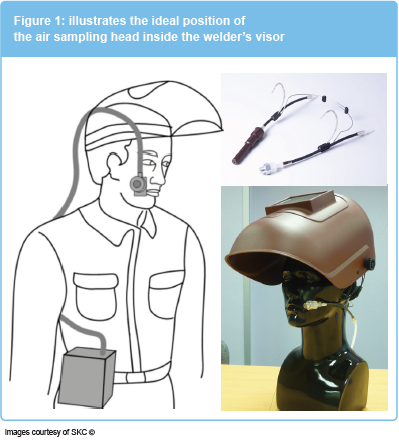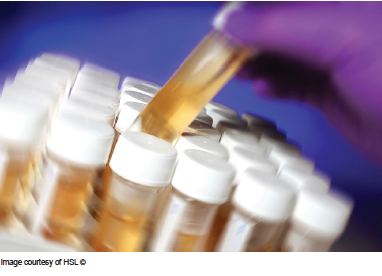Monitoring
means measuring exposure to hazardous substances, to establish if control is adequate.
means measuring exposure to hazardous substances, to establish if control is adequate.
measures the concentration of a chemical in the air in a person’s breathing zone.
involves analysis of breath, urine or blood samples collected from an employee.
Air monitoring and measurement may be needed where there is a serious risk to health from the inhalation of welding fume and the likely exposure level of the welders to the fume is not known, e.g. during the manual metal arc (MMA) welding of stainless steel.
Monitoring may also be needed to help confirm that the control measures in use are working correctly, as a deterioration or failure of engineering controls could result in welders being exposed to high levels of fume.
Under the Control of Substances Hazardous to Health (COSHH) system, an initial exploratory exposure monitoring exercise may be needed to reach an accurate judgement about the risk to health. The results will then influence the assessment of how well control measures for the welding fume are working. The investigation will also need to look at other factors that can influence exposure on the day, such as the production rate setting the amount of welding work needed. These things will influence the personal results of the survey for exposure to welding fume.
When an employer appoints a person to carry out exposure monitoring, they should ensure the person is competent to do so. Those monitoring exposure should demonstrate:
BOHS, as the Chartered Society for Worker Health Protection, provides a list of qualified consultants in its Directory of Occupational Hygiene.
Exposure measurement can involve personal air monitoring, ie measuring the amount of a substance in a worker’s breathing zone, in order to estimate the individual’s exposures to the particulate component of the fume and give an indication of control effectiveness. This involves getting operators to wear sampling devices whilst they work (See Figure 1 below).

Personal air monitoring results can be compared with the relevant set workplace exposure limits (WELs) which are published in the HSE book EH40/2005: Workplace Exposure Limits In-house limits can also be set and used to compare with results for task-specific exposures. There is no single WEL for welding fume. Therefore, exposure measurements should be compared to the appropriate limits for the different constituents in the welding fume, such as: iron oxide, hexavalent chromium, nickel and manganese. Hexavalent chromium and nickel in welding fume are both defined occupational carcinogens. This means that there is a requirement to reduce exposure to these constituents to a concentration which is as low as is reasonably practicable (ALARP). For other substances which have a WEL but are not carcinogens or can cause asthma, adequate control of exposure will involve controlling exposure to below the WEL.
Any revised WEL, which might be implemented, will require improved fume control measures for many welding processes.

An air monitoring survey can also use suitable fixed-site air samplers (also known as static samplers) to provide an overall assessment of airborne concentrations of a substance. Fixed-site air samplers do not directly represent employee or personal exposure. However, these results can help identify:
Air monitoring and biological monitoring are not a substitute for putting good fume control solutions in place to protect the health of workers. You can also use other methods to demonstrate that exposure to welding fume is adequately controlled.
Air monitoring and biological monitoring are not a substitute for putting good fume control solutions in place to protect the health of workers. You can also use other methods to demonstrate that exposure to welding fume is adequately controlled.
Biological monitoring can also be used for investigating the extent of exposure following a report of ill health.
Biological monitoring for stainless steel welders should include the measurement of nickel and chromium in a urine sample and this should be undertaken on an annual basis where control has been shown to be good. Samples should be collected at the end of a typical working week.
Biological monitoring can also be used for exposure measurement for other metal fumes, including, for example; cadmium or lead, which should be measured if the metal has been cadmium plated or if lead paint (lead oxide primer) is present. To determine recent exposure to cadmium or lead, a blood sample will be required. The table below sets out the recommended biological monitoring analytical method for various metal types.

Employees cannot be compelled to provide biological monitoring samples without consent. Biological monitoring is a specialist activity. Urine samples are usually collected by either an occupational hygienist (www.bohs.org ), or occupational health professional (doctor or nurse) (www.som.org.uk ). The samples are then sent to a specialist laboratory (www.hsl.gov.uk ) for analysis by post.

HSE’s COSHH Essentials for Welding, Hot Work and Allied Processes (WL series)
Approved Code of Practice and Guidance:
Control of Substances Hazardous to Health (L5)
Monitoring Strategies for Toxic Substances (HSG173)
Biological Monitoring in the Workplace (HSG167)
Control of Lead at Work Regulations (L132)